Video of the Week:
Mulch: Trees Need to Breathe
Turfgrass:
Bermudagrass Control
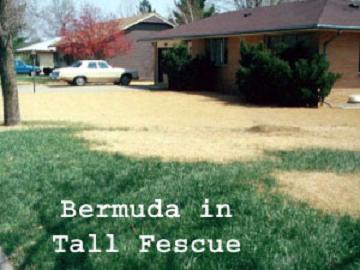
So, how do you control bermudagrass that has invaded a cool-season lawn? Research conducted in 1996 showed that glyphosate (Round-up, Kleen-up, Killzall, Kleeraway) is the best herbicide for the job. Glyphosate is a nonselective herbicide and will kill everything— including tall fescue or Kentucky bluegrass. Therefore, you will need to reseed treated areas. In our study, we applied a 2% solution of glyphosate on July 15 and again on August 15 on a bermudagrass plot that was more than 15 years old. More than one year later, we saw no regrowth. Glyphosate works best if bermuda is growing well. The better the bermudagrass is growing, the more chemical is taken up and pushed into the roots. Water and fertilize if needed to get it going.
Spray about the middle of June (or when the bermuda is growing well). Use glyphosate (2% solution). Wait two weeks and scalp the lawn (mow as low as possible and remove clippings). This will prevent dead grass from covering any bermuda that starts to recover. Wait another two weeks and spray again with glyphosate if there is any green. Wait two more weeks and reseed. (Ward Upham)
Fruit:
Prop Up Fruit Tree Limbs if Needed
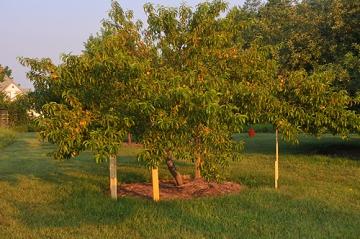
Here's how. Cut a "V" on the top edge of the board on which the limb will rest so that it doesn't slip off. Long limbs that are heavily loaded with fruit may need a prop in the center and another to support the outer part of the limb. A plastic belt-like material that is about 2 inches wide may also be used. This can be tied to a heavily loaded limb, then to a large diameter limb above for support. Where a large limb is used for support, it is good to have it supporting limbs on opposite sides so the weight is balanced. Another solution is to wrap a tape or belt material around the tree in a spiral to prevent limbs from bending until they break. Heavy twine may be used, but it should be removed when the fruit is picked or soon after so it does not cut into the bark on the limb.
Check trees regularly, up to two times a week during the last month the fruit are maturing. You will find additional limbs that need support. Tending to the heavily loaded tree limbs will reduce the number of broken limbs and help keep a balance of the fruiting wood in your tree. Next year, prune long, weak branches back to a side branch to help prevent this problem. (Ward Upham)
Tan or White Drupelets on Blackberry and Raspberry Fruit
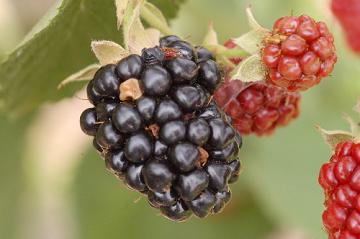
Neither condition affects the eating quality of the fruit unless the stink bug releases the “stink” with which it is associated rendering the fruit inedible. By the time damage is seen, it is too late for control. (Ward Upham)
Vegetables:
Harvesting Potatoes
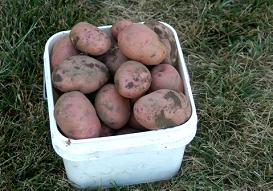
Pests:
Japanese Beetles (JB)
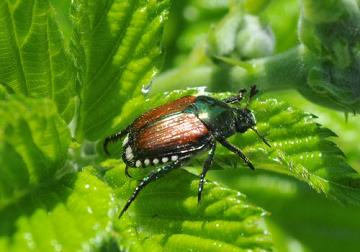
While some individuals prefer to calculate/record accumulated Growing Day Degrees 50 as a method to predict the initial yearly appearance of Japanese beetles, one can more easily set out traps baited with the JB pheromone and floral lure. The bonus is that this also tells an individual that JB actually are “in-the-neighborhood” as evidenced by their being captured.
First 2015 reports of JB captures: Desoto June 9; Manhattan June 15; Topeka June 16. Look for their numbers to rapidly increase. People concerned with JB feeding on landscape plants need to be vigilant in inspecting plants for the presence of JB. If present and if in damaging numbers, corrective actions should be undertaken.
Refer to K-State Research and Extension Publication MF3151 – Japanese Beetle (Bob Bauernfeind)
Walnut Caterpillars
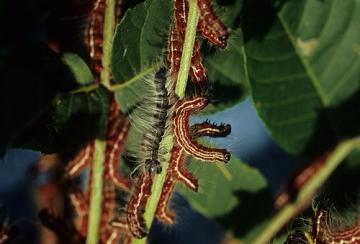
Walnut caterpillars overwinter as pupae underground beneath host trees. In late spring, moths emerge and deposit egg clusters on lower leaves. By the end of June, newly emerged and gregarious larvae skeletonize leaves. Larger hairy, brick-red larvae consume greater amounts of leaf tissue, and nearly matured gray larvae devour entire leaves, including petioles.
As mentioned earlier, walnut caterpillars are gregarious. In other words, they feed in groups. A single tree may contain several groups.
When disturbed, larvae arch their bodies in what looks like a defensive move. Larvae crowd together on the lower parts of trees to molt and leave an ugly patch of hairy skins. Mature larvae, 2 inches long, descend or drop to the ground where they enter the soil to pupate. A second generation occurs soon, creating the overwintering pupae.
Removing leaves with egg masses is an effective way to control walnut caterpillars. This may be impractical with large trees or when too many infested leaves are present. Bands of Tree Tanglefoot pest barrier may be used to snare larvae as they migrate to main branches or the trunk to molt. Insecticides such as spinosad (Conserve; Captain Jack’s Dead Bug Brew; Borer, Bagworm, Leafminer and Tent Caterpillar Spray) permethrin (numerous trade names) malathion or cyfluthrin (Tempo, Bayer Vegetable and Garden Insect Spray) may provide the most practical means of control. (Ward Upham)
Spittlebugs on Eastern Redbuds
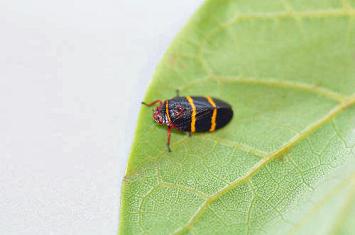
Spittlebug nymphs suck plant juices like aphids, but they remove so much water and carbohydrates that excess fluid is produced. They cover themselves with this fluid and then produce the spittle by bubbling air from the tip of the abdomen into the liquid. The spittle mass helps protect the nymphs from drying and predators.
Spittlebugs normally do not achieve high enough populations to cause damage. If they do, forcefully hosing the plants several times should achieve the level of control needed. (Ward Upham)
Miscellaneous:
Herbicide Drift Damage
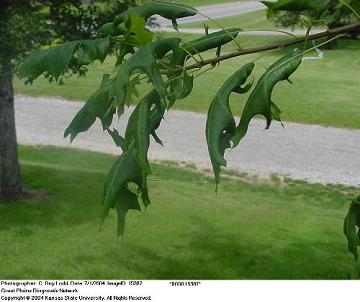
Volatilization is a different problem altogether, and almost impossible to trace back to a source. Some herbicides, particularly the ester formulations of 2,4-D and related chemicals are prone to vaporize, and move off site. The conditions that promote volatilization (high humidity, low wind speeds) are different than conditions that promote drift (high wind speeds). Sometime the damage is caused by the homeowner themselves, spraying for weeds in their lawn.
The various oak species are quite sensitive to herbicide exposure, especially when the new leaves are just expanding. It is the time-sensitive nature of exposure that will lead to normal leaves being found on the same twig as badly distorted leaves. Redbud is another tree species that is very sensitive to herbicides. However, the presence of twisted and cupped leaves on your tree does not mean that tree will die. If most of the leaves remain green, and if new leaves emerge without symptoms, the exposure was not severe enough to do any real harm. This is a recurring problem, due to agriculture being the dominant land use in Kansas, but fortunately the damage, although striking visually, is usually just superficial, and the tree will grow out of it just fine. (Charlie Barden)
Contributors: Charlie Barden, Extension Forester, Bob Bauernfeind, Entomologist; Ward Upham, Extension Associate
To view Upcoming Events: http://tinyurl.com/fswqe
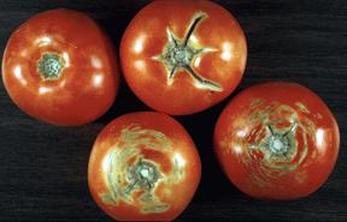
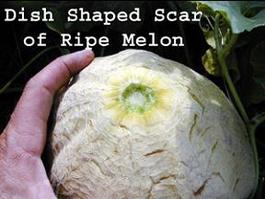
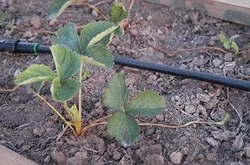
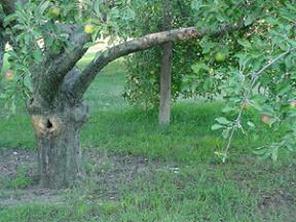
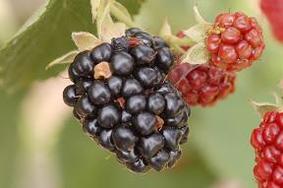
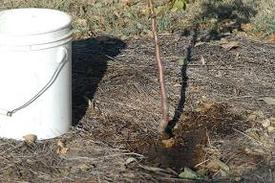
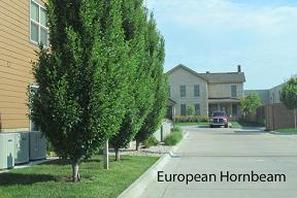
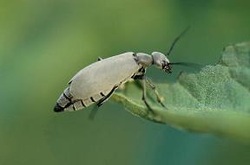
 RSS Feed
RSS Feed
